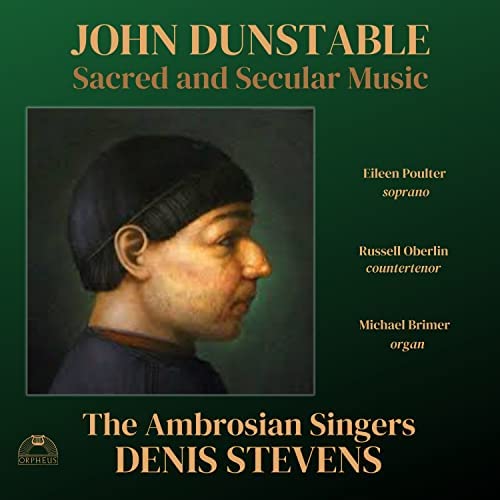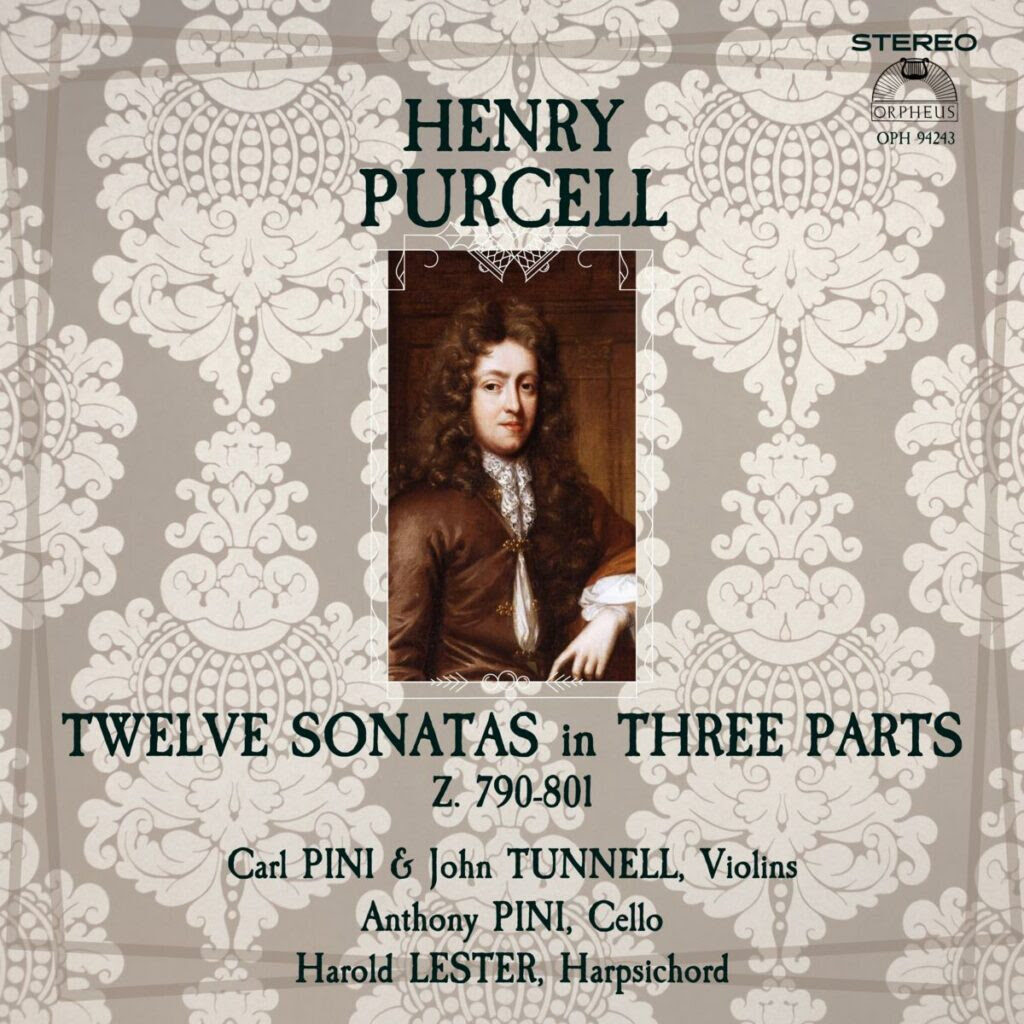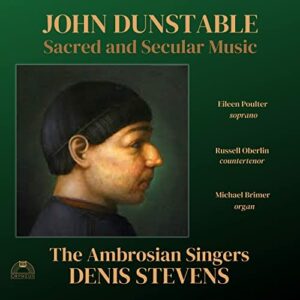Program: #23-10 Air Date: Mar 06, 2023
To listen to this show, you must first LOG IN. If you have already logged in, but you are still seeing this message, please SUBSCRIBE or UPGRADE your subscriber level today.
The famous sub-label under the Musical Heritage Society has been revived with some lost rarities. This week: “John Dunstable: Sacred and Secular Music" with the Ambrosian Singers, and “Henry Purcell: The 12 Sonatas in Three Parts."
The return of the Orpheus label on Musical Concepts is a story of the revival of America's largest and yet least-known classical music record label. The Orpheus label was long a part of the Musical Heritage Society, a record club and record label started in New York City in the early 1960s by Dr. Michael Naida.
Naida, who made recordings for Westminster in the 1950s, had a vision of a "society" where members would receive recordings in the mail, and be kept aware of developments and new recordings via "The MHS Review”, which became one of the earliest "record clubs".
Dr. Naida sold MHS - the club and the record label - in the late 1970s. The new owners, the Nissim family, with a strong background in direct mail marketing, grew MHS to over 500,000 members in the late 1980s and 1990s.
The MHS record club was sold in 2011, but the record label remained in the hands of the owners. Only a few hundred jazz and classical recordings on the MusicMasters label remained available in digital form, for downloading and streaming. Very few of the early MHS catalog appeared in digital form, or on CDs or LPs.
In 2021, Musical Heritage Society completed the first true detailed research into the MHS catalog of recordings since the label and record club was purchased. They discovered that Musical Heritage Society owned over 2,000 recordings, either purchased by the Society or made by the Society's engineers and producers since the mid 1960s - far exceeding their estimates.
Musical Heritage Society approached Musical Concepts with the idea of reviving the Orpheus label - where historic and well-regarded MHS recordings could be restored and available to classical music lovers, with vastly improved sound (even from the LP era) and restored liner notes.
Long-lost recordings from Ruth Slencnzyska, Huguette Dreyfus, the Austrian Tonkunstler Orchestra are scheduled for release, as well as many performances of New York City's early music groups. including the New York Consort of Viols. Also scheduled for release on Orpheus are a series of recordings created by early music pioneer Denis Stevens. An indefatigable force for the neglected music of the Renaissance and English baroque - particularly of Claudio Monteverdi and Henry Purcell - Stevens was responsible for the discovery of many Monteverdi and Purcell works, and their initial performances. One title scheduled to be released on Orpheus is believed to be the first recorded performance ever of Monteverdi's Il Combattimento. Also scheduled are several recordings from his group The Ambrosian Singers, which feature Neville Marriner, as well as other leading lights of the English classical music scene. And his reworking of John Gay's The Beggar's Opera - which led to its revival as a work that could be performed worldwide is also scheduled for early 2023.
I. John Dunstable: Sacred and Secular Music

The life of John Dunstable (d. 1453), like that of so many other medieval musicians, is still very much of a closed book. He probably took his name from his native town in Bedfordshire, and we know he served the Duke of Bedford, brother of Henry V, as a member of his private chapel. Since the Duke was Regent of France, Dunstable must have known even in his youth a life of continual travel. He prob- ably received his training as a chorister in the Chapel Royal. In 1418, the Duke removed six men from the Chapel to accompany him on his European journeys, and it is likely that one of these men was John Dunstable. He became a conano of Hereford Cathedral in 1419, but this would not have interfered with his travels in the service of the Duke. For nearly twenty years John Dunstable lived in France and probably visited neighboring countries as well. By far the greater number of manuscripts containing his work is found in continental libraries; hardly any remain in England. The political upheaval caused by England’s withdrawal from France (Dunstable’s writing down of an astronomical treatise in 1438 coincides roughly with the date of the retur to England of the Duke’s chapel) and the cankerous intrigue that was eventually to burst forth as the Wars of the Rose may well have caused his retirement from the musical world and from the rigors of medieval travelling. He appears to have written no music during the last fifteen years of his life. Between the epitaph referring to him as “as astrologiana a mathematician, a musician, and what not” and Thoma Morley there is hardly reference to him by an Englis writer. However, the glowing testimonies of Tinctoris, Martin le Franc and Eloy d’Amerval more than make up the the lack of interest in England. Tinctoris stresses the suave character of Dunstable’s music, mentioning that the composer stands at the forefront of “a new art whose fount and origin is held to be among the English. This new art was in fact nothing more than a fusion of the harmonic factors inherent in English descant and the contrapuntal ingenuities of the French Ars Nova. It was just this marriage of smooth harmony and flowing counterpoint that made Dunstable’s music, at least for a while, unique in Europe- at its best, as Tinctoris tells us, fit "not only for men and for heroes, but even for the immortal gods." The selections on this disc were transcribed and edited by Manfred Bukofzer: They may be found in his great collected edition of Dunstable's music (Musica Britannica, volume VIl) whose page numbers are referred to directly after the title of each item.
Ave maris stella (p. 95) Hymns, sequences, and certain canticles were usually sung during the Middle Ages in some form of alteration, either that of two sides of a choir, or of monophony and polyphony, or of monophony and organ. Dunstable chooses the second of these methods for his setting of this hymn and alternates choral plainsong with soloist and instrumental accompaniment, here played on the organ. Puisque m' amour (p. 137, arrangement for organ) From the Buxheim Organ Book, and similar in style to the arrangement of O rosa bella (refer below).
Puisque m'amour (p. 136) This text, whose authorship is unknown, is found in the Parisian anthology Le Jardin de Plaisance, published about 1501. Dunstable's music enjoyed wide circulation and an almost bewildering number of optional contratenor parts. For the performance here recorded, the version from a chansonnier in the monastery of Escorial has been preferred. Gloria in excelsis (p. 23) A large-scale composition in four parts not based on plainsong. Dunstable shows in this work his love of sonority and of metrical as well as dynamic contrasts. It is almost certainly an early work.
Regina celi letare (p. 101) A Marian antiphon sung at Compline, intended for use during and after Easter. The plainchant heard at the outset continues in the upper-voice part, and each section ends with Alleluya. Although this is probably an early work of Dunstable’s, and there is as yet no Consciously careful handling of declamation, the clear And luminous texture admirably enhances this song of Praise to the Queen of Heaven.
Speciosa facta es (p. 124) In this processional antiphon for Vespers of the Nativity of the Blessed Virgin, and for the First Sunday after Trinity, the mood is quiet and the melody graceful. The style and texture of the motet are not dissimilar to those of the secular chanson, and occasionally studied declamation makes its appearance.
Sancta Maria, non est tibi similis (p. 121) This processional responsory is typical of the many intimate compositions that Dunstable wrote for the feasts of the Blessed Virgin. The overall effect is one of sincere simplicity and devotion, and the rose and the lily are thrown into relief by a short duo section.
O rosa bella (p. 135, second arrangement for organ) This intabulation of a song usually attributed to Dunstable (though it occurs in most sourceswithout his name) is taken from the Buxheim Organ Book. Most of the characteristics of these late fifteenth century German arrangements are present here.
Quam pulchra es (p. 112) One of the Marian antiphons for Sundays from Trinity to Advent. The style of this motet looks forward to the Renaissance in its close alliance of words and music. The rhythm of the music depends upon that of the text, and it is highly probable that a cappella performance was intended.
Sanctus”Da gaudiorum premid” (p. 43) This composition, together with a Credo based on the same plainsong, may once have belonged to a complete Mass cycle whose Gloria and Agnus Dei have not been preserved. Its references to breaking loose the chains of strife and binding fast the bonds of peace may refer to such a special occasion as the signing of the peace treaty of Troyes in 1420 between England, France and Burgundy.
In 1953, the year that marked the quincentenary of John Dunstable’s death, the BBC Third Programme broadcast a series of six programs of his music, for which the present writer acted as producer. The world-famous expert on Dunstable, Manfred Bukofzer, planned the series and supplied the music. It is hoped that this recording will serve as a modest memorial of Bukofzer’s life and work, which came to a regrettably early end in the fall of 1955. --DENIS STEVENS Professor of Music Columbia University in the City of New York
- Ave Maris Stella 3:39
- Puisque M'amour (Organ) 1:14
- Puisque M'amour 5:02
- Gloria in Excelsis 6:02
- Regina Coeli Laetare 5:25
- Speciosa Facta Es 2:01
- Sancta Maria 2:31
- O Rosa Bella (Organ) 2:03
- Quam Pulchra Es 2:18
- Sanctus and Benedictus: Da Gaudiorum Premia 5:44
- Albanus Roseo 6:07
II. Purcell: Twelve Sonatas in Three Parts, Z. 790-801
Carl Pini, violin
John Tunnell, violin
Anothony Pini, cello
Harold Lester, harpsichord

Purcell’s chamber music deserves to occupy an important place in the experience of musicians and listeners, not only because of its intrinsic excellence but because its being non- descriptive or absolute music-devoid of any text that might date it or weigh it down-enables us to perceive its beauties and subtleties with as much readiness as did the Londoners of the later Stuart era. Musical life in the city displayed signs of a vigorous and active growth in the last quarter of the seventeenth century. It was the era of the first public (or semi-public) chamber music meetings, and although these began in a haphazard way they eventually settled down into a routine not unlike the concerts of today. The elder John Banister, a violinist and composer for the theatre, hired an out-of-the way room in a London inn at Whitefriars, filled it with tables and chairs and constructed an alcove for the musicians. One shilling was charged for admission, and members of the public were expected to make their musical preferences heard. They paid the pipers, and it was they who called the tune. Fraught with imperfections as this type of concert was prone to be, it was the kind of musical gathering to which the young Henry Purcell was brought up.
Continental music of various schools and styles helped to mold his own manner of writing, which was however strong enough in character to absorb such influences completely and make the resulting music unmistakeably English and peculiarly Purcellian. He knew the music of Monteverdi and Carissimi, of Cazzati, Colísta and Vitali, and of Jean-Baptiste Lully; and even though the Italian influences upon his chamber music have been made much of in recent years, there is no doubt that he was as partial to the charms of an English consort ayre as he was to a sonata by Schmelzer or Becker. Diedrich Becker, a Swede by birth, is singled out by Roger North as the composer of some of the best printed consort music of the time, and the works to which he was referring specifically were in all likelihood the Musicalische Fräblings-Früchte of 1668, an anthology of consort music of three, four, and five parts, and the Erster Theil zweystim- miger Sonaten und Suiten of 1674.
It will be noticed that Purcell’s chamber music also appeared in these forms: the fantasias of three, four, and five parts, written in 1680, and the two sets of sonatas belonging to a somewhat later date, and published in 1683 and 1697. Whatever the tributary sources of Purcell’s fantasias and, they nevertheless remain unique repositories of his own special technique of modulation and transition, highly personal melodic sense and his ability to employ bold strokes of chromaticism which invariably sound logical and consistent. Purcell was only twenty-four years old when the first set of sonatas came out in 1683, and prior to this publication (which was offered to subscribers for the sum of ten shillings) only a few of his songs had appeared in print. The issue of these twelve sonatas was thus a great event in Purcell’s life, and was enhanced by the elegant title page, the portrait of himself made by R. White, the dedication to King Charles II, and the Preface to the Reader. No pains were spared to present an accurate and worthy edition.
- Sonata No. 1 in G minor, Z. 790 (6:31)
- Sonata No. 2 in B-Flat Major, Z. 791 (7:14)
- Sonata No. 3 in D Minor, Z. 792 (7:12)
- Sonata No. 4 in F Major, Z. 793 (7:30)
- Sonata No. 5 in A Minor, Z. 794 (6:28)
- Sonata No. 6 in C Major, Z. 795 (6:33)
- Sonata No. 7 in E Minor, Z. 796 (7:53)
- Sonata No. 8 in G Major, Z. 797 (6:08)
- Sonata No. 9 in C Minor, Z. 798 (8:11)
- Sonata No. 10 in A Major, Z. 799 (5:44)
- Sonata No. 11 in F Minor, Z. 800 (6:03)
- Sonata No. 12 in D Major, Z. 801 (6:10)
Composer Info
John Dunstable (d. 1453), Henry Purcell
